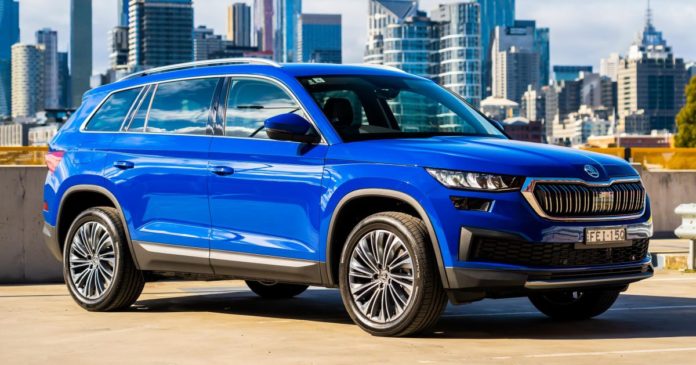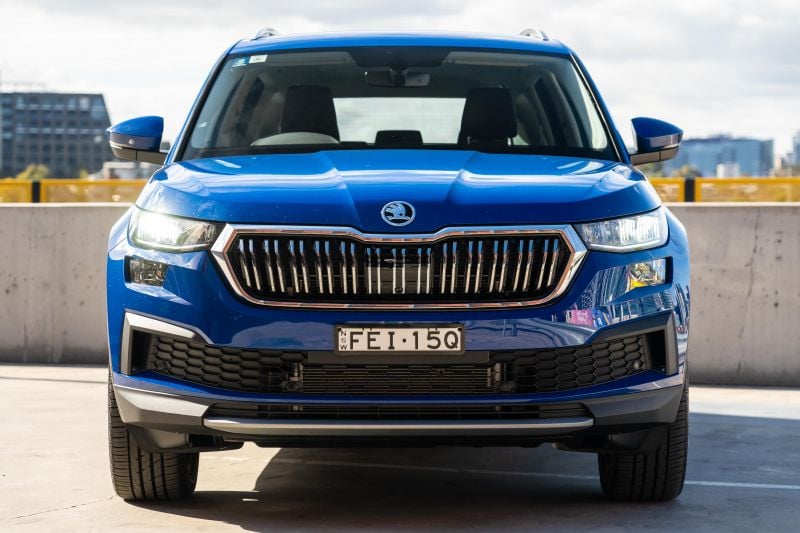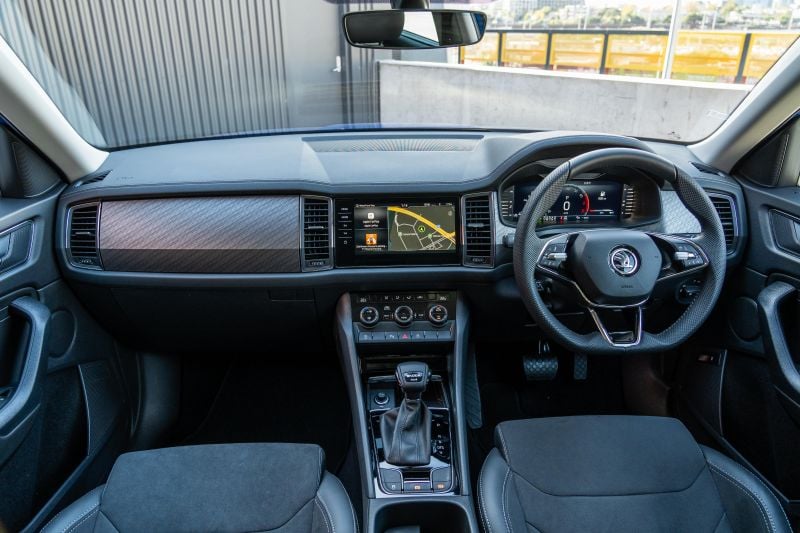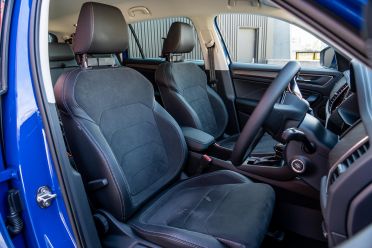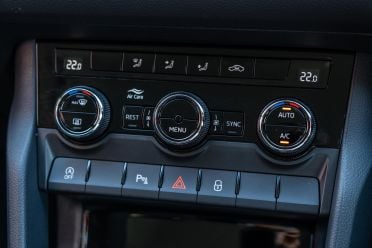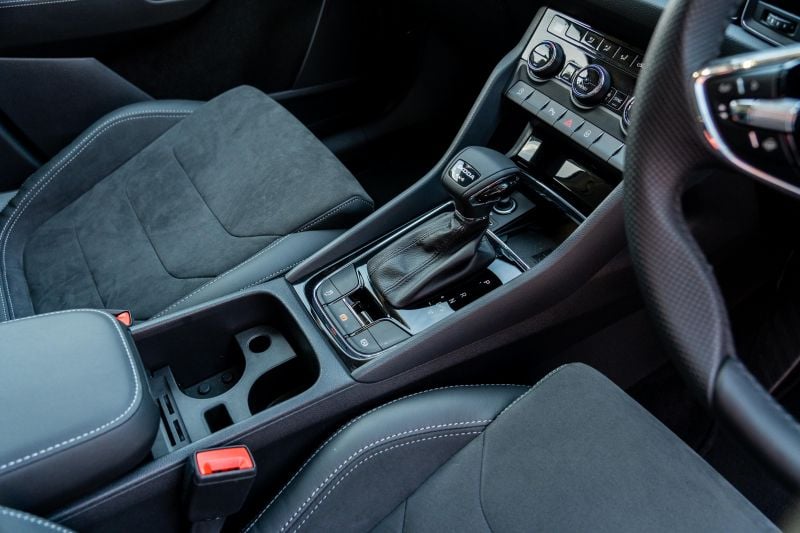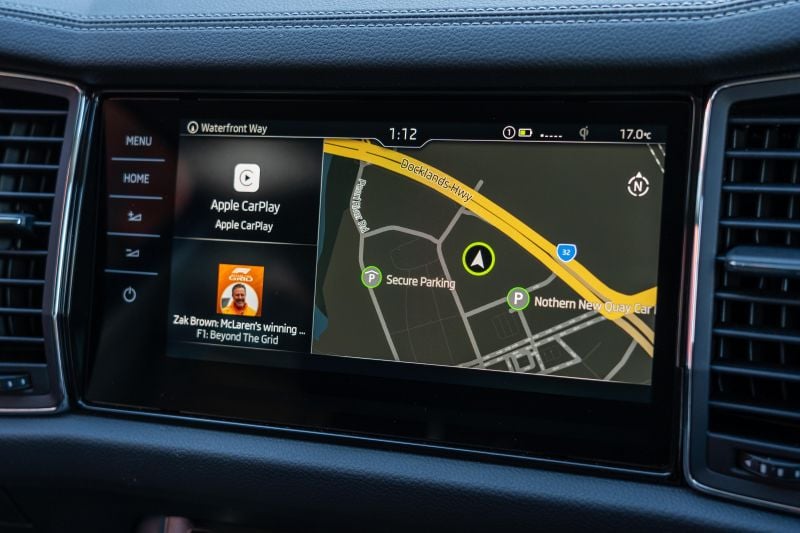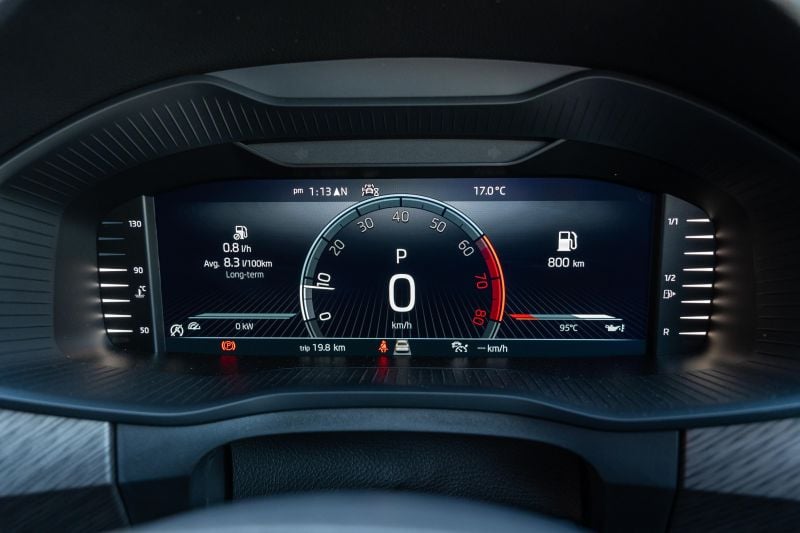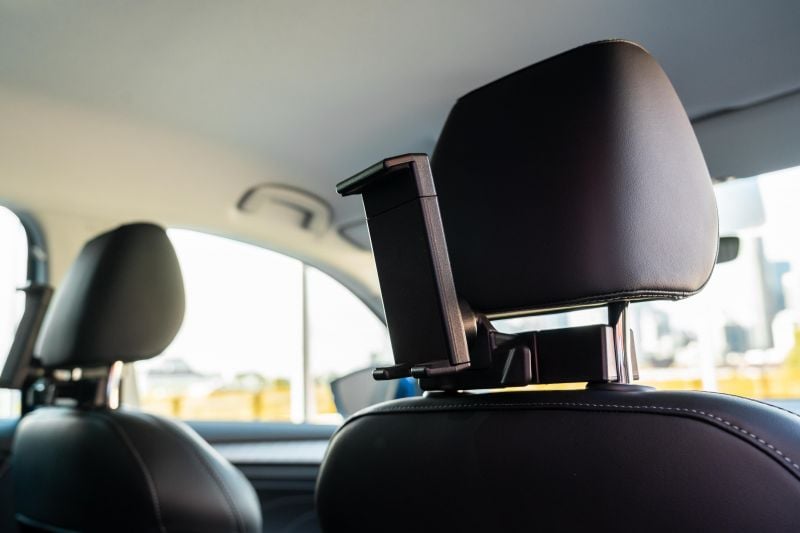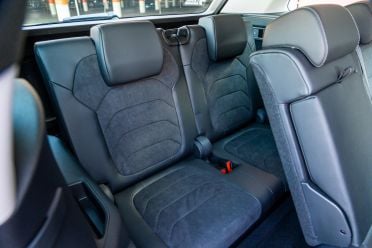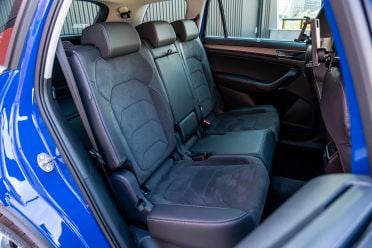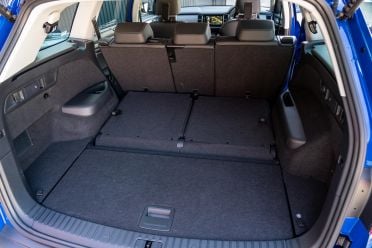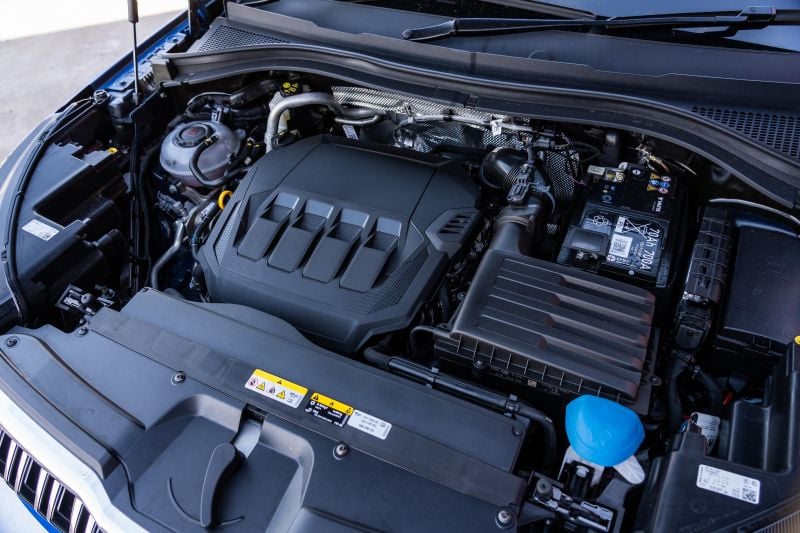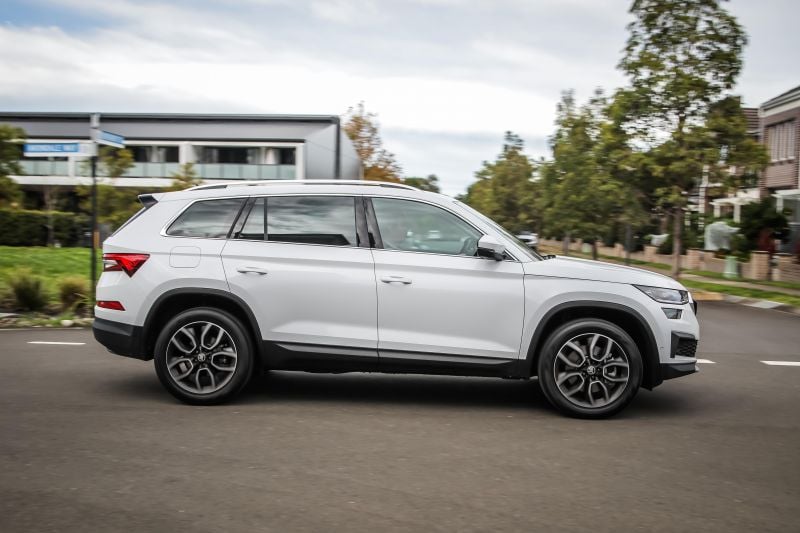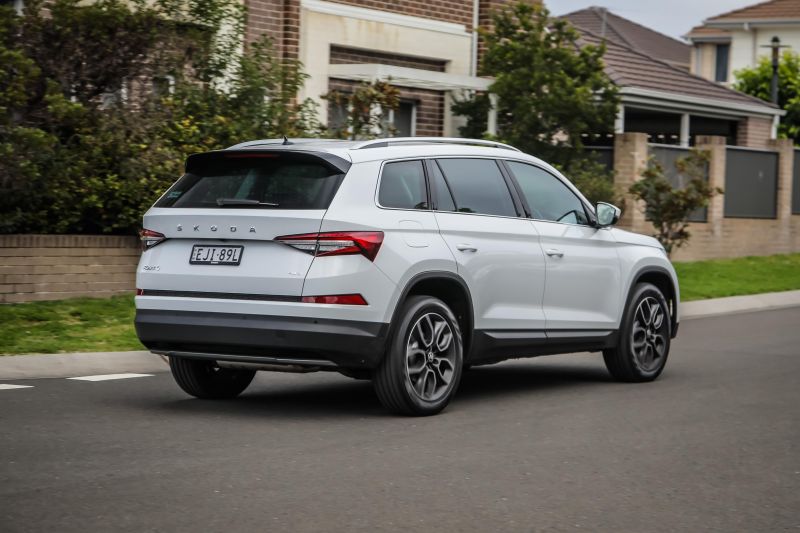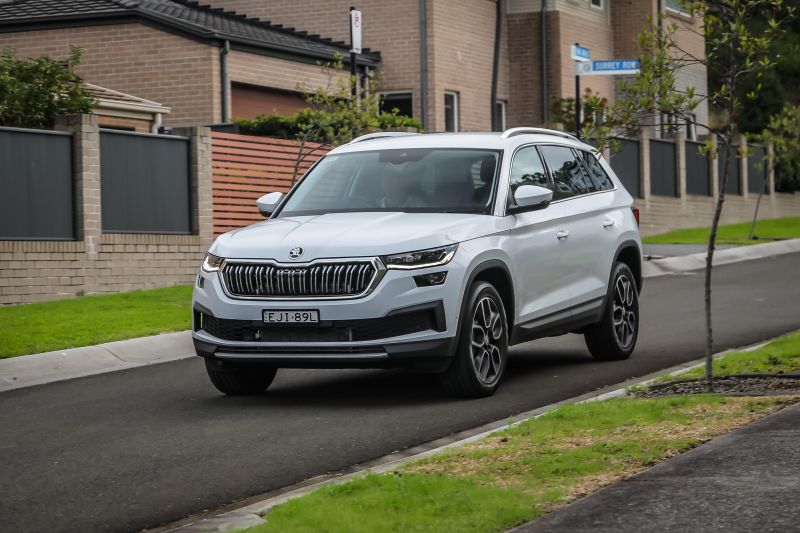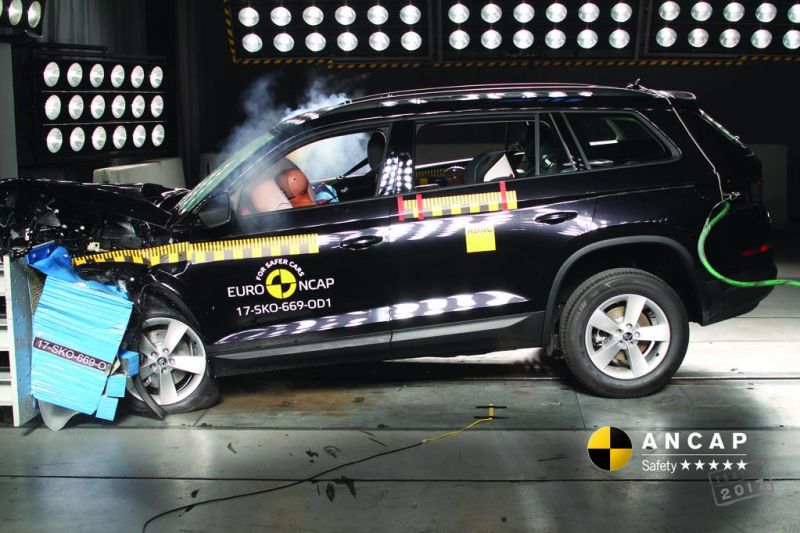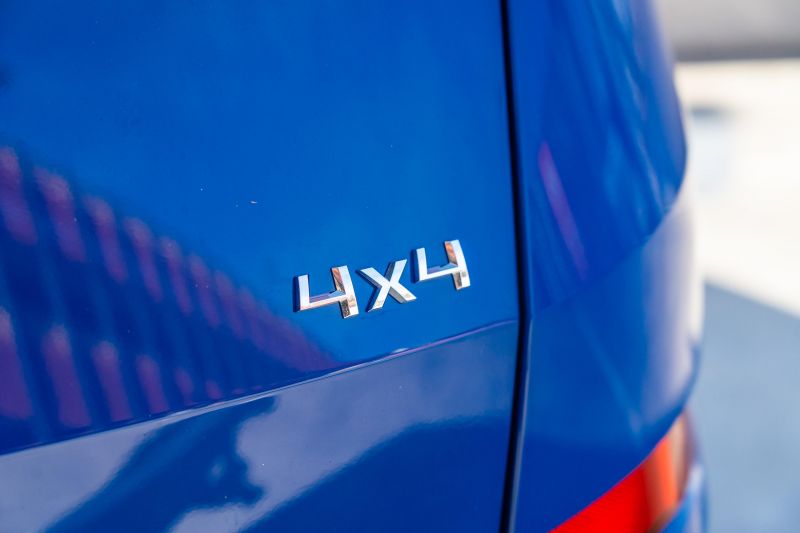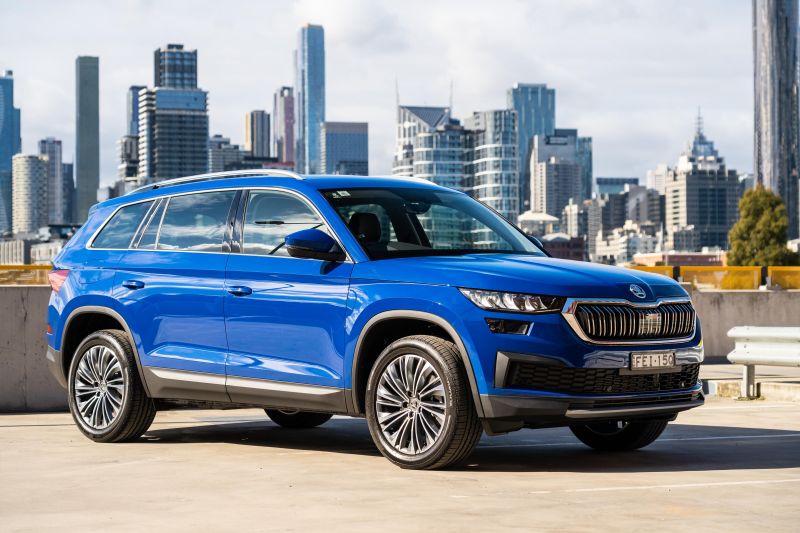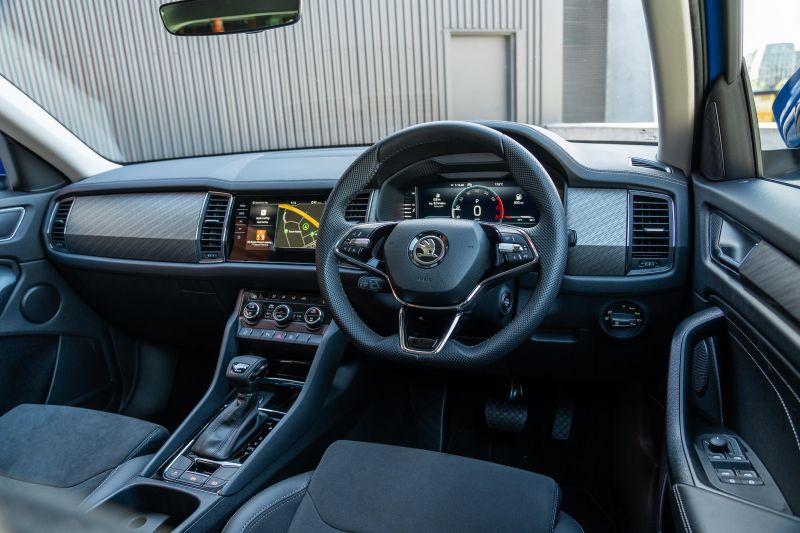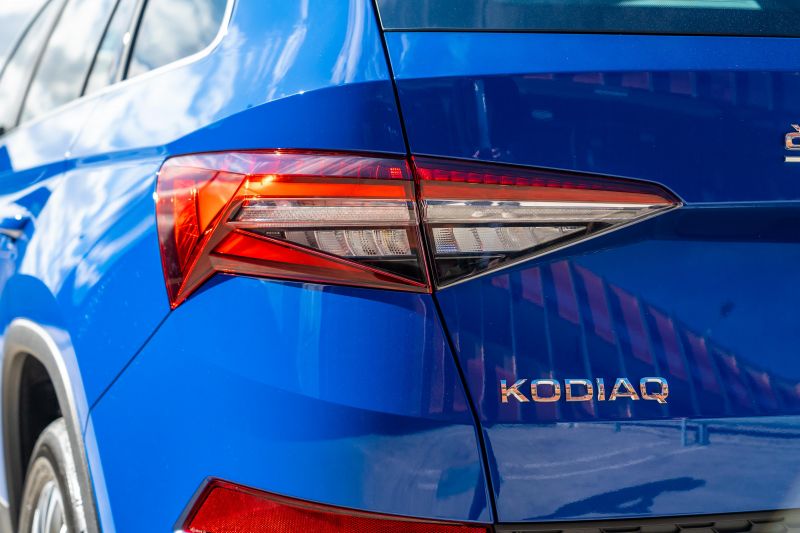You’re looking at the cheapest version of Skoda’s flagship SUV in Australia – for now.
It’s the Skoda Kodiaq, and given it was released in 2016, it’s not surprising the Czech manufacturer is looking to switch things up with a new generation on the way this year.
The current model was treated to a mid-life update in 2022 that largely focused on improving tech functionality rather than upgrading looks – but it left some nicer safety kit as an optional extra on base models.
Still, the Kodiaq has remained one of Skoda’s top-sellers in Australia, second only to the Kamiq with 1555 examples sold in 2023.
On test here is the entry 2024 Skoda Kodiaq Style, which has all the same bones as its more expensive siblings but misses out on some of the nicer things like lane assist and a surround-view camera.
It still has a turbocharged engine and four-wheel drive system like the rest of the range, and it’s competitively priced in a packed segment that is growing every year.
Does the ageing Czech still have what it takes to compete with newer overseas competition, or should you wait for the new Kodiaq to touch down?
How does the Skoda Kodiaq compare?
View a detailed breakdown of the Skoda Kodiaq against similarly sized vehicles.

Skoda
Kodiaq
How much does the Skoda Kodiaq cost?
There are three Kodiaq models available in Australia, and the base Style on test here is priced at $56,490 drive-away.
| Model variant | Drive-away price |
|---|---|
| 2024 Skoda Kodiaq Style | $56,490 |
| 2024 Skoda Kodiaq Sportline | $56,490 |
| 2024 Skoda Kodiaq RS | $76,890 |
Skoda is currently offering a run-out discount on the middle Sportline variant that matches its price with the Style, as it gears up for the arrival of the SUV’s next generation in November this year.
To see how the Kodiaq Style lines up against the competition, check out our comparison tool.
What is the Skoda Kodiaq like on the inside?
It’s by no means an uncomfortable or unsightly interior, but the Kodiaq is starting to feel its age alongside flashy new rivals.
The seats are upholstered in a combination of leather and what Skoda calls “Suedia”, and with lumbar support they’re comfortable to sit in for long periods of time despite being a little wide and flat. That is, once you get them adjusted.
Despite asking more than $55,000 drive-away, this base Kodiaq lacks any form of power adjustment for the front seats. In addition to the typical levers, there’s a knob at the base of the seatback that adjusts the reclining angle.
It took me a second to find, and front passengers complained it was more difficult than powered adjustment or a lever.
Once you’re in and comfortable, you’ll be able to take in the stylish simplicity and sheer spaciousness of the cabin.
There’s loads of room all around, and you definitely won’t be cramped in the front row. While it presents well, the interior ambience would benefit from the addition of the black headliner fitted to the more premium Kodiaqs.
In front of the driver is a very well-proportioned and good-looking steering wheel. It features sporty, ergonomic sculpting and is wrapped in quality perforated leather.
The buttons and rolling dials on the wheel are of good quality and feel nice to use, while the rest of the cabin’s controls fall easily to hand and work as they should. There are physical buttons and knobs for the climate control in the middle, and the headlights are controlled by a Volkswagen-sourced selector to the right of the wheel.
They say with age comes wisdom, and the Kodiaq proves it to be true with its simple climate controls that mean you don’t have to wrestle a touchscreen if you want to change your fan speed or adjust the temperature.
A downside is the inclusion of gloss-black trim elements, which can scratch easily and are hard to keep clean. It’s not really about how much of it there is, but rather where it’s been placed.
It’s all over the car’s key touch points – the climate controls, on the spokes of the steering wheel, and it covers the entirety of the wireless phone charger’s sliding cover. That cover also feels flimsy, with more play than we’ve come to expect from Volkswagen Group products.
There’s an actual gear shifter in a conventional configuration, and the centre console box is reasonably sized. It’s covered by a soft-touch lid that slides to reveal two central cupholders, though they are on the smaller side.
Flip the removable cupholder insert and you instead get a coin tray; an example of the classic Skoda touch designed to differentiate the Kodiaq from the related Tiguan Allspace.
Between the dashboard’s plastic cladding (which is swapped for a carbon-fibre appearance in higher trim models) you’ll find the Kodiaq’s 9.2-inch infotainment screen, which is somewhat dated in appearance and small by today’s standards.
At least everything on the screen is where you’d expect – it doesn’t take a rocket scientist to switch from satellite navigation to radio, or from vehicle settings to smartphone mirroring. The only thing that would make it easier to navigate would be a couple of physical buttons in place of the touchscreen ones for ‘menu’ and ‘home’.
Wireless Apple CarPlay and Android Auto are included standard across the Kodiaq range and worked reliably in our week with the car, and it’s nice to get a wireless charger too. My phone did get quite hot after having sat on it for an hour’s drive though, which is common to most brands.
Your alternatives are limited to two USB-C outlets in the front and a 12-volt outlet in the rear, so passengers will need to come prepared if they need to charge up.
Behind the wheel is a 10.25-inch instrument screen, which is logically laid out and can show different displays with a variety of information.
If you don’t like one display, chances are you’ll find another look in there that suits better.
Flanking the screen are two vertical light gauges for water temperature and fuel level. Some rivals have more modern looking fonts and graphics, but none can match the sheer range of options you get here – with a map between the dials a particular highlight.
There’s a third stalk on the steering wheel for the adaptive cruise control (ACC). Unlike Volkswagen, Skoda has stuck with this arrangement even in the new Kodiaq – which takes some getting used to if you were expecting wheel-mounted buttons.
From my driving position I couldn’t see the whole stalk, so I had no idea how to adjust the set distance to the car in front while using ACC.
Turns out there’s a multi-position switch on top, which is obstructed by the steering wheel’s left spoke. It’s the sort of thing you’d learn quickly if you owned the car, but took a moment to figure out and adjust to.
A similar switch is used to adjust the speed of the intermittent wipers, and interacting with it is more fiddly than necessary. A conventional rotating selector would’ve been fine.
Stepping up and into the back is easy thanks to the Kodiaq’s large doors and high roofline. Once seated, there’s plenty of space all around regardless of how tall you are.
Seating in the middle row is firm but spacious, and it’s appointed with two vents and a centre fold-down armrest with cupholders which are probably only good for coffee cups or small plastic bottles.
Those seats slide to reveal the third row, which can be unfolded using the pull strap. Keep in mind there’s really not much room here because even if it’s a seven-seater, the Kodiaq doesn’t have massive dimensions.
As such, the third row is the compromise. For comparison, the Kodiaq’s body is around 100mm shorter and 20mm narrower than both a Santa Fe and a Kia Sorento.
It’s fine if you need to move a lot of people a short distance, but it’s not an ideal arrangement for adults on longer trips. Space in the second row becomes compromised if you’re utilising all seven seats and want to slide the bench forward, too.
There are two ISOFIX anchors on the outer second-row seats, as well as three top tether points.
The boot is where the Kodiaq’s interior comes into its own, as it boasts one of the most spacious cargo areas in its segment.
At 765L with the third row folded, it’s smaller than only the chunkier GWM Tank 500 (795L) and Isuzu MU-X (1119L). That means you won’t be limited for what you can fit, though space is severely compromised if the third row is up – as is the case in rivals.
With both rear rows folded down, the space opens up to a maximum 2005L, matching the largest measured capacities of the Sorento (1995L) and Jeep Wrangler (2050L).
Unlike most of its competition, though, the Kodiaq settles for a space saver spare in lieu of a full-size alloy.
| Dimensions | Skoda Kodiaq Style |
|---|---|
| Length | 4697mm |
| Width | 1882mm |
| Height | 1681mm |
| Wheelbase | 2790mm |
| Boot capacity (VDA) | 270L (3rd row up) 765L (3rd row folded, to seatback) 2005L (all seats folded, up to roof) |
To see how the Kodiaq Style lines up against the competition, check out our comparison tool.
What’s under the bonnet?
There’s one powertrain shared across Kodiaq Style and Sportline variants, and they both come with all-wheel drive as standard.
| Model | Skoda Kodiaq Style |
|---|---|
| Engine | 2.0-litre 4cyl turbo |
| Power | 132kW @ 6000rpm |
| Torque | 320Nm @ 1400rpm-3940rpm |
| Transmission | 7-speed dual-clutch automatic |
| Driven wheels | Four-wheel drive |
| Weight | 1855kg (tare) |
| 0-100km/h | 8.4 seconds |
| Fuel economy (claim) | 8.2L/100km |
| Fuel economy (as tested) | 8.0L/100km |
| Fuel tank size | 58 litres |
| Fuel requirement | 95 RON |
The 2025 Kodiaq is set to include a boosted 2.0-litre engine with 150kW, which will better align it with Skoda’s European specifications.
To see how the Kodiaq Style lines up against the competition, check out our comparison tool.
How does the Skoda Kodiaq drive?
Once you get moving, the Kodiaq hits its stride. It’s smooth, quiet, and has plenty of power to get you by.
-
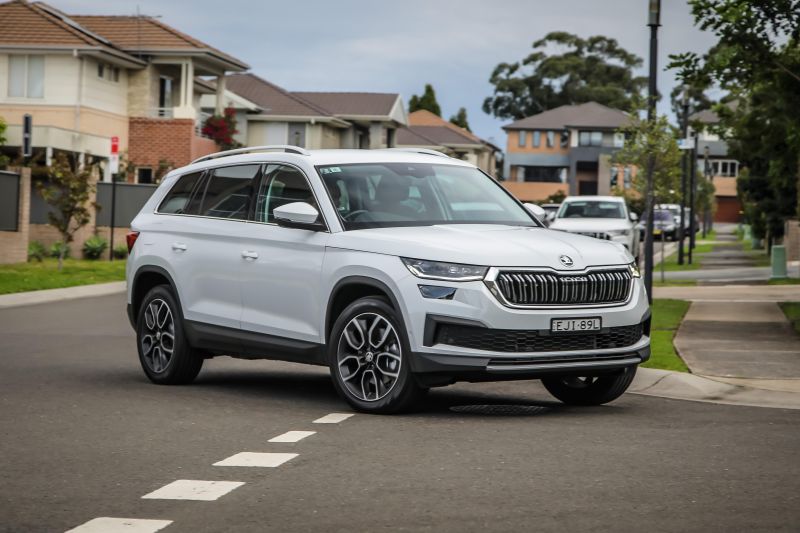
MY22 Kodiaq Style shown
Pressing the start/stop button (located where a key barrel would’ve been) fires up the engine with a typical cold idle, but it doesn’t produce any notable racket and dies down quickly as it gets up to temperature.
Despite being the cheapest Kodiaq available, it’s comfortable on the move with little road noise entering the cabin. Small bumps aren’t a worry, and even bigger imperfections on the road won’t unsettle the car in any meaningful way.
The steering is also very light at low speed, which means it isn’t cumbersome or tiring behind the wheel. The feel is also consistent as you speed up, and at higher speed the Kodiaq feels sure-footed.
At low speed the Volkswagen DSG behaves as expected of dual-clutch transmissions. It’s easy to be caught out if you’re coming from an older vehicle or a car with a more conventional torque converter arrangement when you first hop behind the wheel.
That’s not to say it doesn’t work well, but it does have a unique feel in first and second gear as it revs up from a stop but doesn’t move away all that fast. It doesn’t take long to dial into how it feels, and the tune in the Kodiaq is pretty friendly around town.
High-speed cruising is definitely a strength, as once you’re above third gear the shifting of gears is almost imperceptible. Tied in with the refined on-road cabin experience, it makes for very comfortable driving once you’re out of town.
The turbocharged engine has enough punch to either get you moving or quickly accelerate past another vehicle, although there are times where it feels a bit like a small heart powering a big car.
As good as it is in other areas, it sometimes needs a moment to kick down when you put your foot down. That means it’s not as quick on its feet as I’d like it to be, but then again it is a seven-seater and that kind of response is perfectly fine for the average punter.
However, once it does find the right gear, the engine is very capable of getting the hefty Kodiaq up to speed without much sweat. It’s reassuring to know it can do it, regardless of whether or not you’ll actually need it to.
In terms of its physical size on the road, the Kodiaq isn’t all that big. At least not for a seven-seater.
If you’re used to a small hatchback or city car it’ll naturally feel different, but compared to other cars of a similar size the Kodiaq sits well within its lane on the highway. It rarely feels like it’ll be too big for a space when parking, too.
That means it’s easy for someone unfamiliar with the car to get in and drive compared to something like a Tank 500, MU-X, or Kluger. It doesn’t take a lot of getting used to, and you’ll quickly feel confident on the road.
It could definitely benefit from some of the driver assistance features offered as standard in the more expensive Kodiaqs, though.
Lane-keep assist would tie in well with adaptive cruise control, while a surround-view camera would make it easier to navigate in tight spaces – both form part of pricey optional packages.
The features it does have – like auto-hold and automatic stop/start – work well, with the latter in particular very consistent in shutting down the engine promptly as you come to a stop and then restarting it smoothly when it’s time to set off.
If you don’t want any of that, there are big, clearly marked buttons on the centre console to turn those features off on a whim.
What do you get?
Three trim levels are available in the Australian Kodiaq range.
Standard equipment on the Kodiaq Style:
- 19-inch alloy wheels
- 9.2-inch touchscreen infotainment system
- Wireless Apple CarPlay and Android Auto
- Wireless phone charger
- Satellite navigation
- 10.25-inch Virtual Cockpit digital instrument cluster
- Power-folding, auto-dimming, heated side mirrors
- Adaptive cruise control
- Dual-zone climate control
- Keyless entry and start
- Power tailgate
- Automatic headlights and wipers
- Door edge protectors
- Leather-trimmed sport steering wheel
- Leather upholstery
- Privacy glass, rear window sun blinds
- LED headlights
- LED daytime running lights
- Fog lights
- LED rear fog lights
- Tablet holders on front seat backs
Kodiaq Sportline adds:
- 20-inch alloy wheels
- Alcantara/leather sports seats with silver stitching
- Matrix LED headlights*
- Headlight cornering and poor weather function*
- Gear shift paddles*
- Power-adjustable driver’s seat*
- Drive mode selection
- Progressive steering
Kodiaq RS adds:
- Leather-trimmed sports seats with RS logos
- Heated front and rear seats*
- Ventilated front seats*
- DAB+ digital radio
- Red brake calipers
- Carbon-style interior trim
- Panoramic sunroof
- Adaptive dampers
- Off-road mode
- Tri-zone climate control*
- 12-speaker Canton sound system*
- Hands-free tailgate operation
- Surround-view camera*
*Available for the Style as part of an optional package
Is the Skoda Kodiaq safe?
The Skoda Kodiaq does not have a current ANCAP safety rating, but it did achieve a five-star rating in 2017 which expired for vehicles sold from 1 January, 2024.
Standard safety equipment includes:
- 9 airbags
- Driver and front passenger airbags
- Driver’s knee airbag
- Front and rear side airbags
- Front and rear side curtain airbags
- Autonomous Emergency Braking (AEB)
- Adaptive cruise control
- Driver attention monitoring
- Reversing camera
- Front, rear parking sensors
- Blind-spot monitoring
- Rear cross-traffic assist – with braking
- Multi-collision brake
Kodiaq RS adds:
- Lane assist*
- Lane assist with adaptive lane guidance*
- Traffic jam assist*
- Automatic parking assist*
- Emergency assist*
*Available for the Style as part of an optional package
How much does the Skoda Kodiaq cost to run?
Skoda offers a seven-year, unlimited-kilometre warranty across its range. It’s an appealing proposition and can be transferred to a new owner if the car is sold before the warranty is up.
Every new Skoda purchase includes a complimentary one-year roadside assistance membership, and servicing your vehicle at a Skoda dealership will grant you up to 12 months of roadside assistance.
If you have a depleted existing roadside assistance membership at the time of service, Skoda will automatically top it up to 12 months.
The company also offers prepaid service packs, which vary in price between models. For a new Kodiaq, the five-year, 75,000km service pack will cost you $2900, while the seven-year, 105,000km plan is $3350.
Like the warranty, service packs are also transferrable when you sell your car, and you can purchase ‘top-ups’ if you want to extend your prepaid servicing. For example, if you want to top up from five years to seven years for your Kodiaq, it’ll cost an additional $1300.
If you don’t want to go for a prepaid service pack, services will come at 12 month or 15,000km intervals. Prices are outlined for the first seven years of Kodiaq ownership.
| Service interval | Price |
|---|---|
| 1yr or 15,000km | $459 |
| 2yr or 30,000km | $898 |
| 3yr or 45,000km | $459 |
| 4yr or 60,000km | $1568 |
| 5yr or 75,000km | $459 |
| 6yr or 90,000km | $898 |
| 7yr or 105,000km | $459 |
| Total | $5200 |
CarExpert’s Take on the Skoda Kodiaq Style
While the Style is by no means a bad car, the fact it’s the same price as the Sportline coming into the end of its life makes the base grade harder to recommend.
For the most part it’s got enough tech to keep you comfortable, and wireless charging and smartphone mirroring are certainly a nice bonus allowing you to get in and go without fuss.
It still has a small screen with a somewhat dated display, though, and there’s a lack of more charging options in the rear even as the Kodiaq range gets more expensive.
Safety features and drive modes are also missing on this spec and it’s disappointing they’re only included if you choose to add optional extras at the time of purchase.
Given they’re included as standard on the most expensive option, I’d want more of it to trickle down the range on the next-generation Kodiaq.
The on-road experience is definitely where the Style shines, mostly because it’s pretty much the same under the skin as the other Kodiaqs.
It’s smooth, quiet, and the DSG is second-to-none at high speed. In a pinch, the engine has plenty of power to pull you through and doesn’t complain while doing so.
The Style is good on fuel too, which never goes amiss in the context of how expensive everything is these days. If you’re in need of a seven-seater and it has to be European, it’s hard to look past the Kodiaq – even in its base setup.
It’s definitely well worth going for the same-price Sportline or even the flagship RS, though, as they add that little bit of spice that takes this car from good to superb – no pun intended.
MORE: Buy a Skoda Kodiaq
MORE: Everything Skoda Kodiaq

